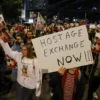Mediators are engaged in intense discussions to prolong the pause in fighting in Gaza, but reaching an agreement is proving to be increasingly difficult for Israel. As the initial ceasefire deadline approached, Israel, Hamas, and the intermediaries negotiating between them were in a frenzy of activity. The original truce was set to last until Monday, but Hamas agreed to extend the ceasefire by one day for each group of 10 captives released by Israel. While the extension was announced, it was only for an additional two days. Despite the challenges, the Qatari and Egyptian mediators used these extra days to work towards convincing both sides to further extend the truce or turn it into a permanent ceasefire.
Negotiations through intermediaries have been arduous, lengthy, and at times frustrating. However, they did yield some results, leading to the initial four-day truce and the subsequent two-day extension. Initially, Israel unilaterally stated that the pause could be extended by releasing more captives, reducing the need for additional negotiations. However, as time went on, talks between Qatari and Egyptian intermediaries became more time-consuming. The agreed-upon lists of detainees to be released were being accepted later and later each day. At one point, Hamas even threatened to abandon the process and allow the truce to collapse.
Now, on Wednesday evening, the situation has become more complex. Hamas has announced its desire for a four-day extension and has even hinted at negotiating the release of all captives it is holding in exchange for a more lasting cessation of hostilities. Israel, on the other hand, has welcomed the potential release of additional captives but has sent mixed messages about the continuation of the pause. In this atmosphere of uncertainty, mixed with anxiety and hope, international mediators are working harder than ever. The highest officials from the US, Israeli, and Egyptian intelligence services have joined the mediation efforts in Qatar for the past two days. Although the presence of Hamas counterparts has not been officially confirmed, it is highly likely that they are also involved in these intelligence discussions.
One would expect that, with the experience of two rounds of negotiations, it would be easier to reach agreements on extending and expanding the ceasefire. However, there are indications that the talks are becoming more complicated and potentially stagnating. The question arises: how did we go from overwhelming optimism during the weekend celebrations of former captives rejoining their communities to the possibility of fighting resuming on Thursday?
Several reasons contribute to the apparent reluctance of both Israel and Hamas to extend the truce by exchanging more captives. Primarily, there are tactical and strategic military concerns, particularly on the Israeli side. In recent days, Israeli military representatives have expressed a preference for the current two-day extension to be the last, advocating for the resumption of fighting on Thursday morning. From the outset of the armed intervention, the Israeli army has been cautious about engaging in a war without clearly defined strategic objectives. Soldiers dislike open-ended tasks and prefer to receive clear and measurable orders. Although Prime Minister Benjamin Netanyahu repeatedly stated that his goal was to destroy Hamas, he failed to provide the military with specific directives. The eagerness to resume fighting is not indicative of bloodthirstiness but rather a reflection of realism.
Following the 7 October attacks, the Israeli military mobilized 360,000 reservists to supplement the standing army of 150,000 soldiers. During the fighting, each reservist and unit knew their specific tasks and purposes, maintaining a military mindset unaffected by civilian sentiments. However, as the pause extended, many reservists returned home for short rest periods, exposing them to the doubts, uncertainties, fears, and hopes of their families and relatives. This temporary reintegration into civilian life may have influenced their determination to fight. As the original ceasefire was set to expire on Monday, the logistics of returning reservists to their units became complicated. Extending the pause further would only complicate leave and rotation schedules, potentially impacting morale and determination. Generals understand the detrimental effects of stop-go-stop-go orders on an army’s capabilities and, therefore, prefer to conclude the fighting rather than prolong it.
In conclusion, negotiations to extend the ceasefire in Gaza face numerous challenges. Despite the initial optimism surrounding the release of captives, reaching an agreement has proven difficult. The tactical and strategic considerations of the Israeli military, alongside the uncertainty within the country’s leadership, contribute to the complexity of the talks. International mediators are working tirelessly to find a resolution, but the outcome remains uncertain. As the deadline looms, the world watches with anticipation for a decision that could either prolong the pause in fighting or reignite the conflict in Gaza.




